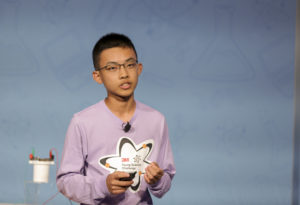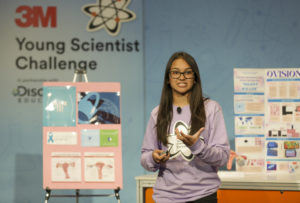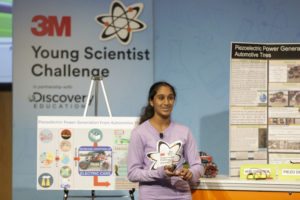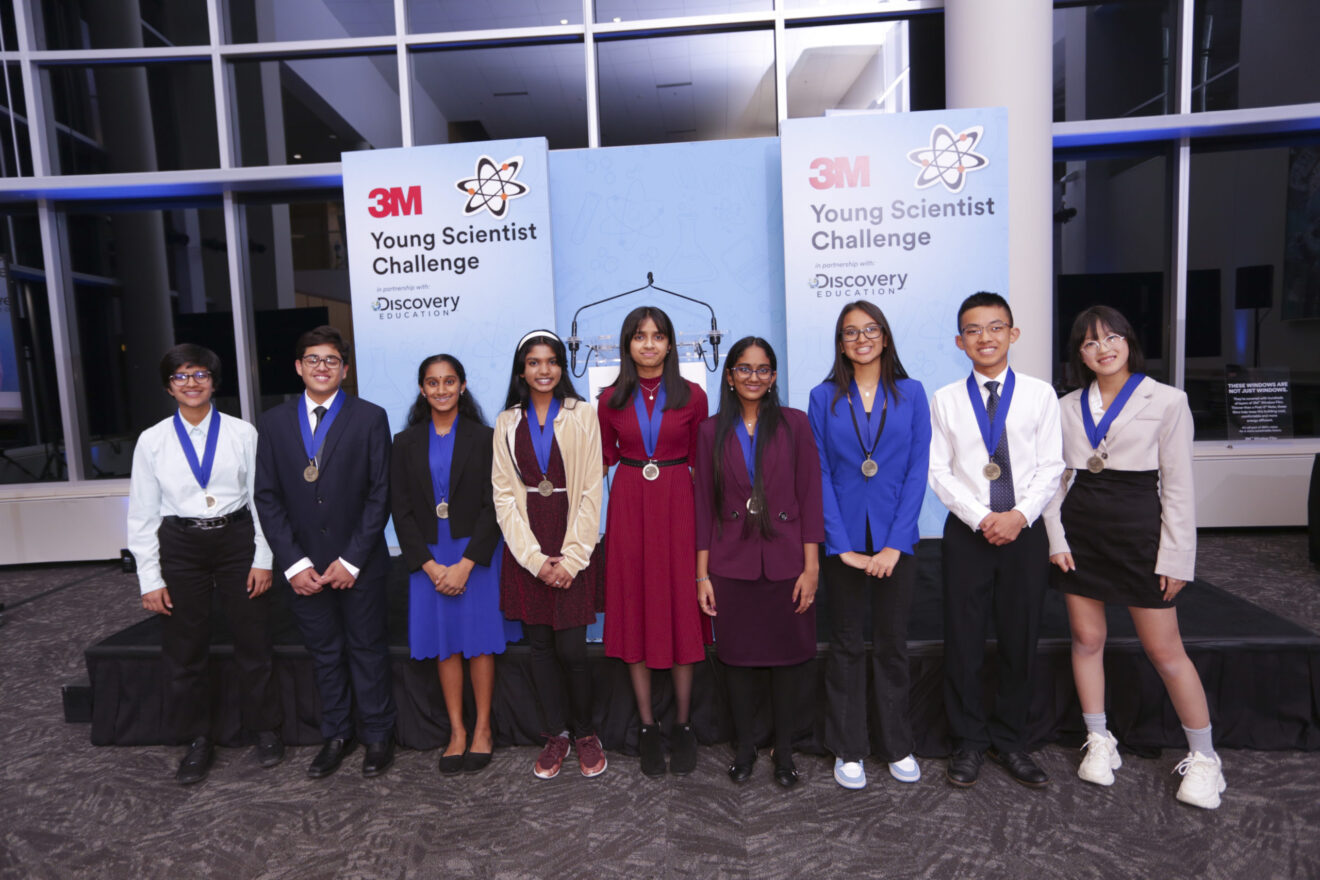SmartBrief’s Q&A with six of the nine finalists for last fall’s 3M Young Scientist Challenge with Discovery Education delves into their projects, their earliest memories of STEM involvement, the challenges they’ve faced and advice for educators who want more students to take STEM classes. We’ve edited for clarity and space. The six we queried are:
Leanne Fan, America’s Top Young Scientist, first-place winner and ninth-grader from San Diego. Project: Finsen headphones designed to treat mid-ear infections using machine learning and phototherapy.
Harini Venkatesh, second-place winner and eighth-grader from Brentwood, N.H. Project: The Comptometrist: An efficient way to determine myopic power.
Shanza Sami, third-place winner and ninth-grader from Iowa City, Iowa. Project: Pura Aerem: Leveraging catalytic converters for enhanced filtering efficacy.
John Lee, finalist and ninth-grader from Oviedo, Fla. Project: A novel mos2 electrode for enhancing electrochemical hydrogen production
Samaira Mehta, finalist and ninth-grader from Santa Clara, Calif. Project: OVision: The automatic assessment of ovarian cancer features and mesothelin protein overexpression from histopathological images using deep learning.
Asvini Thivakaran, finalist and eighth-grader from Round Rock, Texas Project: Piezoelectric power generation from automotive tires.
Read more details about each student and their project, and remember to check out Part 1 of the Q&A.
What advice would you give a teacher or school to help them better engage their students in STEM?
Leanne: I think the best thing a teacher can do to encourage students in STEM is to teach in an engaging way that makes students interested in STEM. I find current and past topics about medicine and research very interesting, so introducing topics like these may encourage students to start their own project.
Harini: Personally, I always loved doing experiments, trying things! That’s one of the reasons why I started doing science fair projects and research — because I was able to try things to find solutions to problems that existed in the real world. One piece of advice that I would give to teachers would be to do experiments that might be beyond the students’ grasp. Even if they can’t yet understand the concept, some of them will be more motivated to keep learning and try to figure out why the result of the experiment was what it was, and when they find it, it’s one of the most rewarding experiences. In my experience, curiosity was always the most motivating factor, and I know that it’s what got me into STEM as well.
Shanza: Engage students in STEM by providing immersive activities and allowing students to individually draw real-world connections from them. Allowing students to communicate and collaborate through the scientific process is also crucial to creating a better environment and seeing new perspectives.

John: My advice would be that if a student has an interest or idea, encourage them to stay curious about that topic, research it and potentially create a prototype that might be able to aid in solving that topic or problem. Furthermore, I would encourage teachers and schools to connect students with professionals to assist in visualizing their ideas.
Samaira: I suggest making these concepts engaging and hands-on. When kids feel involved and excited, they are more likely to retain their learnings.
Asvini: I would say if all the science teachers could let us do more hands-on activities that require critical thinking and real problem-solving skills, that would help better engage students in STEM subjects. It gives them a better understanding and makes them interested in the STEM.
Have you seen any great ways (or have your own ideas) for teachers/schools to encourage regular students (rather than just the advanced or gifted/talented) to get interested in STEM?
Leanne: I think labs are a great way to get all students interested in STEM. Being able to actually conduct experiments instead of just reading about them makes people a lot more interested!
Harini: I don’t think that encouraging regular students should be any different from encouraging gifted/talented ones! No matter their IQ, no matter the extent of their knowledge, something that blows your mind has the same effect across the board! By showing students what STEM can do for the real world and showing them what kinds of wonders STEM can create, teachers can encourage all students alike to see how amazing science can be!
Shanza: I would like schools to encourage more hands-on activities in the science curriculum, to engage more students in STEM. Events such as science fairs and camps were what initially gained my interest in science, so incorporating more interactive activities would be beneficial towards all students. Offering programs and clubs related to STEM, both in and out of the classroom, would be a valuable learning experience for all students.
John: Before being interested in STEM, I was a regular student myself who wasn’t advanced or gifted. When I started my first-ever STEM research project in seventh grade, I shared some interests or ideas that I had with my STEM teacher. Then, she would provide suggestions and tips on what I could do in the process of research. Since becoming involved in STEM, I became interested in computer science and biochemistry.

Samaira: My favorite childhood memory was my parents taking me to local science museums, festivals and fairs as a kid. I truly believe some of the hands-on activities I did there sparked my interest in STEM.
A particularly vivid memory I have is of the Children’s Discovery Museum in San Jose, Calif. I remember putting a ball over a machine that pumped air and seeing the ball float! As a 4-year-old, this was especially fascinating, since I had never ever seen anything like this before. I remember as I grew older I began connecting these concepts to things like Bernoulli’s Principle. I truly believe it was experiences like these that built a solid foundation for my love of science, and it’s hands-on experiences like these that can help spark a love for science within everyone.
Asvini: The science teachers in my school have always made us do lots of engineering and science-related projects, projects that make us think and learn and are more closely related to worldwide issues. I find this to be a really good idea that should be done for all kids to get a better experience of what STEM really is.
As part of the 3M Young Scientist Challenge, you got to work with a mentor. Can you tell us about that experience and what effect it had on you and your research?
Leanne: My 3M Young Scientist Challenge mentor, Ross, has a lot of experience with patents and working in labs on products. Being able to just meet with a scientist who is actively trying to make someone’s life easier is amazing, and the knowledge my mentor has really helps inspire me to try harder and look further into my research.
Harini: I loved working with my mentor! It was such a rewarding experience, and it really helped me stay on track to finish my prototype! I was also able to connect with other 3M scientists who could help me with my project, and that was just so cool!
Shanza: The experience of working with my 3M mentor, Dr. Patrick Zimmerman, was incredibly enlightening. Dr. Zimmerman enabled me to think with a scientific perspective — guiding me through the scientific process, giving me the insight to overcome barriers, and effectively communicating with others to make progress with my research. He used his knowledge on 3M technology to recommend products to integrate within my prototype. Dr. Zimmerman was also a very supportive figure throughout the Summer Mentorship Program –- he continued to root for me even when I felt discouraged. Ultimately, the experience of getting to work with a mentor helped me make huge strides in the research and engineering process of my innovation.
John: As many might expect, it was a unique yet an incredible once-in-a-lifetime experience. During the summer mentorship, my mentor helped me decide what 3M products to use in my project and also helped me prove that my reaction worked on my newly developed electrode prototype by contacting a fellow 3M scientist, who was able to take microscopic images of the electrode. If I am to be offered another opportunity like such, I would definitely accept it and work hard to solve a problem that I’m interested in.
Samaira: It was an amazing experience to connect with industry professionals and research scientists who helped guide the scaling of this project. The deep learning convolution neural network that I used in my project has a versatile use in and out of the medical field; while it is very helpful in precision medicine, it can also greatly help out in fields such as industrial automation. It was so much fun to see how I could utilize 3M products to further enhance my project to explore other critical issues that I can help find an innovative solution to using things like my DLCNN and 3M technologies.

Asvini: The 3M Young Scientist Challenge with Discovery Education is a great opportunity for kids who are interested in science, and working with a real scientist from 3M is an honor and great experience for middle-schoolers like me. I was thrilled to work with my mentor, Dr. Kannan Seshadri, who navigated me in many ways through this Young Scientist Challenge to come up with solutions to solve real-world problems.
He helped me to think like a real scientist and guided me to come up with new ideas of experimentation. My project got proved in many ways that we can generate piezo electric power while driving. Additionally, if we increase the thickness of the piezo layer, there is a high chance of increasing the power generation. Working with a 3M scientist and mentor brought me lots of confidence and improved my knowledge.
What’s next for you?
Leanne: I want to start testing my product on real ear canals and get a patent on my headphones! It would be great to eventually be able to sell my Finsen headphones and send them to people in need.
Harini: I plan to continue and expand my project this year, as I believe that my prototype is just the beginning! The 3M Young Scientist Challenge was an amazing experience, but I know that my project can be more than what it is right now!
Shanza: In the future, I see myself continuing to refine my innovation, Pura Aerem. I hope to have Pura Aerem become a widespread piece of technology, being distributed to automotive companies and car servicing chains. Ultimately, I would like to utilize the power of science to address global issues and create innovations that make a positive impact on the world — be it in terms of health care or climate change. Making progress for the underprivileged is of big interest to me, one that I am compelled to address with science.
John: My future plans are to investigate what other electrodes and electrolytes there are that could potentially help improve electrochemical hydrogen production. I want to assist in the efforts to shift to a greener energy industry in replacement of fossil fuels, which can help with sustainability and prevent further climate problems.
Samaira: Besides my research project, I have also created a series of fun, educational board games called CoderBunnyz, CoderMindz and CoderMarz, which aim to simplify the complex concepts of coding and AI for young kids across the world. While I understand, that not every kid will choose to become a professional coder when they grow, I believe a basic understanding will make them better thinkers for whatever they choose to go on and do in their life. With my creations, I have held over 500 free workshops and motivational talks in order to introduce kids to the magical world of computer science.
When I was younger, however, I noticed very few girls were coming to these coding workshops, and there was always a plethora of boys. And, too, from a very young age, I grew up questioning our current society. This led to my love for activism, especially equality for women, as I grew.
Today, I’ve been named a “champion for girls in technology” by the UN. This summer, I took a course called “Sociology of Inequality” from Stanford University, where I learned how we can use our legal system as a tool to create potent change for minorities (like women).
In addition, I was recently elected to the Santa Clara Youth Council, a group of 15 teens who serve as an advisory committee, providing the City Council, including the mayor and other honorary officials, with valuable insight regarding youth and teen issues in the community. Throughout the years, we work on creating projects that will benefit the youth and bridge the generational gap between seniors and kids to see how we can all work together to create a more beautiful city.
Asvini: My next plan is to continue researching more on this power generation while driving and get with car companies to make this applied in the real world.
I am planning to get with universities and corporate companies on research opportunities to further research this idea and application.
Anything else you’d like to add?
Leanne: I would really encourage any young scientists from fifth through eighth grade to join the Young Scientist Challenge! It’s an amazing way to develop your ideas and meet other young scientists. It’s also SUPER fun!
Shanza: Overall, being a part of the scientific community has been amazing. Becoming more immersed in STEM through the 3M Young Scientist Challenge has been a surreal experience.
John: I would like to say a massive thank you to 3M, Discovery Education and everyone else involved in the event. I was able to meet other young scientists from across the nation that had similar interests to me. It was a very enjoyable and memorable experience that I’ll never forget.
Samaira: I live by a quote that is taped by my bedside: “Work while they party, learn while they sleep, live as they dream,” and that truly brings me the most inspiration. I realized, though, at times it may feel like all my peers are out having fun while I’m working. I live by this quote because I genuinely believe in the power of hard work. If you work while others are partying, and if you learn while others are sleeping, then the persistence and dedication will pay off when you live as they only dream.
Asvini: Science touches every aspect of our lives. It plays a vital role in our daily actions and makes our lives easier and comfortable.
The other finalists, who were unavailable for the Q&A, are: Amritha Praveen from Buffalo Grove, Ill., an eighth-grader at Aptakisic Junior High School; Sahasra Swargam from Portland, Ore., a ninth-grader at West View High School; and Daniel Thomas from Colleyville, Texas, a ninth-grader at Colleyville Heritage High School.
Don’t forget! Read more details about each student and their project, and check out Part 1 of the Q&A. Read more about the 3M Young Scientist Challenge with Discovery Education.
Diane Benson Harrington is an education writer at SmartBrief. Reach out to her via email, Twitter or LinkedIn.
Opinions expressed by SmartBrief contributors are their own.
_________________________
Subscribe to SmartBrief’s FREE email newsletter to see the latest hot topics on EdTech. It’s among SmartBrief’s more than 250 industry-focused newsletters.
